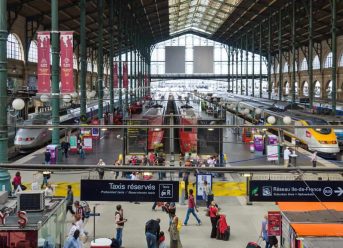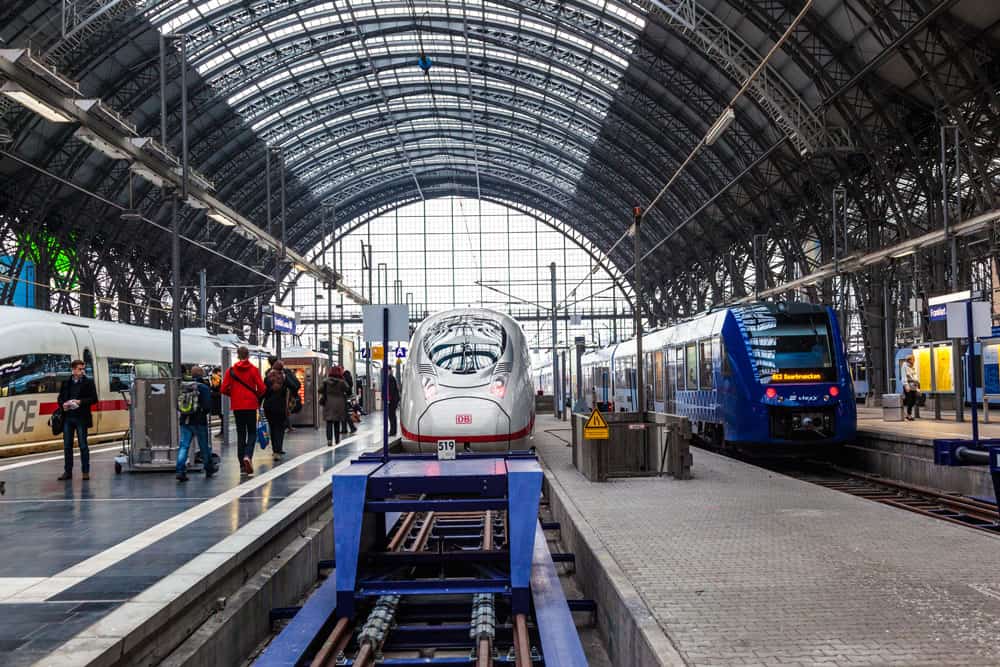
Germany has one of Europe’s greatest rail networks. The trains are fast, frequent, and famous for being punctual. As an added bonus, it’s very easy to book German train tickets online no matter where you’re from. So keep reading because in this Germany Train Guide we’ll cover everything you need to know about traveling through Germany by train—from navigating the system to buying train tickets for the cheapest price.
How To Buy German Train Tickets
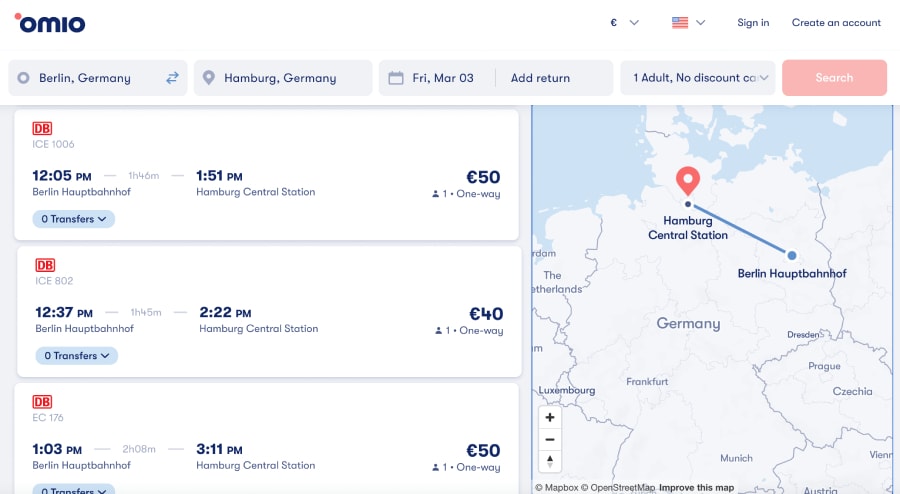
Buying German train tickets is fairly painless since Germany’s rail system’s website is logical and it accepts payments from international credit cards without any hassle. There are also other ways to save (booking early, special tickets, etc.) that we’ll cover below.
Travel Tip: Most train tickets in Germany are now electronic so having reliable high-speed data for your phone is super helpful when traveling by train. Here are a few articles I’ve written to help you get cheap mobile data in Germany: Guide To Mobile Data Plans and Smartphone Phones in Europe, and How To Buy A SIM Card and Mobile Data Plans in Europe.
Where To Buy German Train Tickets
Here are a few places to buy train tickets:
Omio (Recommended)
Omio is a search engine that lets you compare and book trains anywhere in Europe. It allows you easily book tickets with your credit card at essentially the same prices as the Deutsche Bahn website — there is a very small service charge.
Additionally, Omio searches routes for multiple rail services across Europe so it’s great for international trips (since it can easily combine rail journeys of multiple countries).
Train tickets sold via Omio are electronic—simply show the conductor the ticket on your phone (you can also print the ticket if you wish).
TrainLine (Recommended)
TrainLine is another third-party booking site that connects directly to Germany’s National Rail Network and it gives you the same prices you’d find there. They also take international credit card payments without any hassle.
Additionally, it searches routes for multiple rail services across Europe so it’s great for international trips (since it can easily combine rail journeys of multiple countries).
Train tickets sold via TrainLine are electronic — simply show the conductor the ticket on your phone (you can also print the ticket if you wish).
Buying German Train Tickets via Deutsche Bahn—aka the German Rail System
You can buy German train tickets directly through Germany’s national rail system — Deutsche Bahn (www.bahn.de). It accepts most international credit cards and tickets can be sent to you electronically or printed at home.
While rare, sometimes you might encounter some translation issues when using Deutsche Bahn—which is why I prefer using Omio or TrainLine.
NOTE: German train tickets can be purchased about six months in advance.
Buying German Train Tickets At The Train Station
You always have the option to buy your train tickets from any train station in Germany. Every train station will have automated ticket machines and ticket windows. All the machines have an English-language option and most employees staffing the ticket windows will speak English.
DO I NEED TO BUY GERMAN TRAIN TICKETS IN ADVANCE?

Long-Distance Trains
Yes. For high-speed/long-distance trains in Germany, you should book early to get the best price—fares rise as the departure date approaches. For example, a ticket purchased on the day of travel can cost 3x-4x the price as one bought a month or two in advance.
These high-speed trains include InterCity Express (ICE), ICE Sprinter, InterCity (IC), Eurocity (EC).

Regional Trains
No. These trains have a fixed price based on the distance traveled. Simply show up at the station, buy your ticket, and hop on the train. These trains are obviously slower and you’ll have more connections. However, you can book them via the Omio or TrainLine app simply for the convenience of not needing to buy them at the station.
Types of German Train Tickets
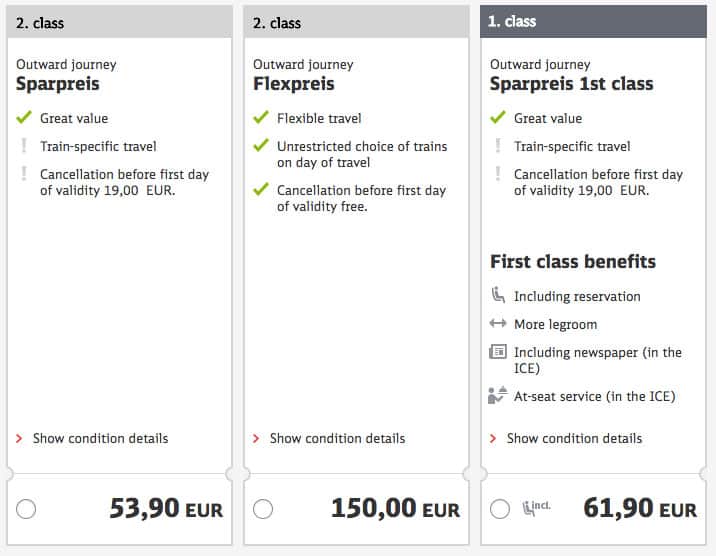
There are two standard ticket types:
- Sparpreis: Sparpreis is a budget ticket that’s valid for a specific route (i.e. it’s not flexible). There is also a first-class version that has the same limitations but you get a few extra perks like nicer seats, more legroom, and access to a nice lounge in large stations — sometimes the first-class and second-class tickets are virtually the same prices so treat yo self.
- Flexpreis: The Flexpreis is a full-price ticket but it offers a lot more flexibility — it’s valid on any train of the day and you can cancel the ticket before the day of travel. It’s also a lot more expensive.
HOW TO COLLECT YOUR TRAIN TICKETS
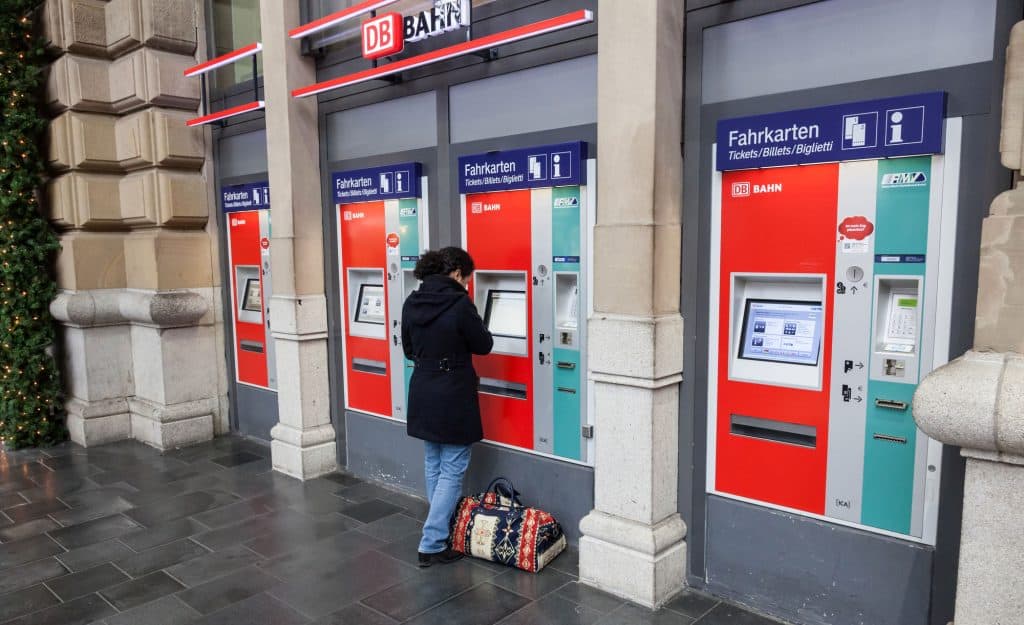
All digital and printed tickets have a QR code that the conductor will scan when they check tickets on the train. It’s super easy.
- Digital Tickets: You can download the ticket as a PDF and save it to your smartphone, tablet, or laptop. This is the easiest way.
- Print: You can also print the PDF.
- DB Navigator App: You can have the ticket loaded to your DB Navigator app.
- Print at the Station: Most of the time you can print your ticket at the station. You’ll be given a code that you type into the ticket machine and it will print there. You can also go to the customer service counter.
- By Mail: Yes, you can get printed tickets mailed to you at an extra cost — I think it’s around €5 and takes a while to arrive.
Tips For Using German Trains
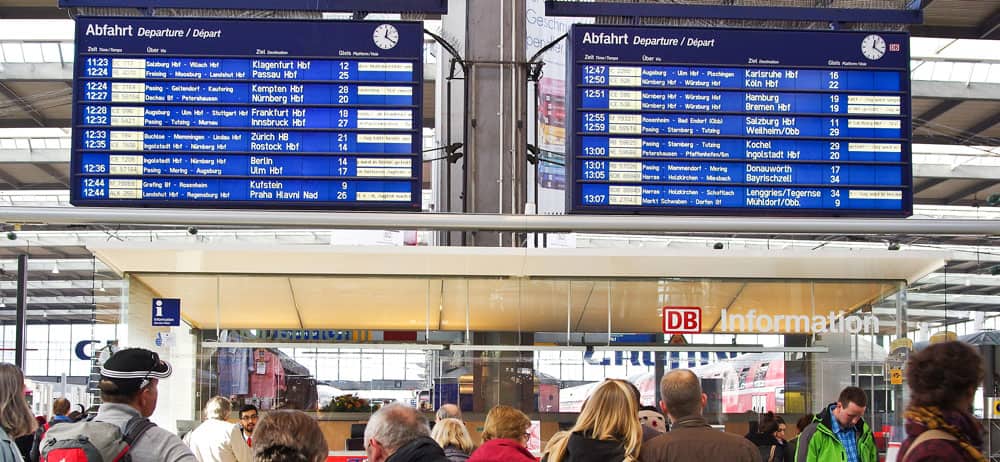
First, we recommend getting to the train station about 20 minutes early so you can find your train platform in plenty of time — by the way, there is no check-in… you simply get on the train. Most are easy to navigate but it’s best to play it safe. Also, if you’re printing a ticket at the station you should leave more time because there can be lines to use the machines.
Once you have your tickets sorted, look at the departure board. This will tell you where to find your train. Pay attention to the board as the platform can sometimes change. Don’t worry if you don’t see your train on the board because they may not list it until it’s closer to departure time.
After you’ve found the platform, use the signs in the station to locate the train. Almost everything should be in English and most Germans speak excellent English.
When the train pulls you’ll want to find your correct car if you have assigned seats (if not, just sit in any non-reserved seat). Each train car will have a number on it so it’s easier to find the car while outside the train than to walk through the train to get to your car. From here, all you gotta do is find your seat.
There is plenty of luggage storage on the train—both above/behind the seats and in the luggage racks at the end of the cars.
Eventually, the conductor will come by to check your tickets.
Rail Passes for Germany
Another great thing about German train travel is that rail passes can actually be a pretty good deal. That’s because they don’t require rail pass users to make reservations — even on the expensive high-speed trains (the exception is overnight trains). So all you gotta do is hop on any train and go.
Check out Eurail.com for the various rail pass options.
Eurail Pass Vs Single Tickets: What’s Cheaper?
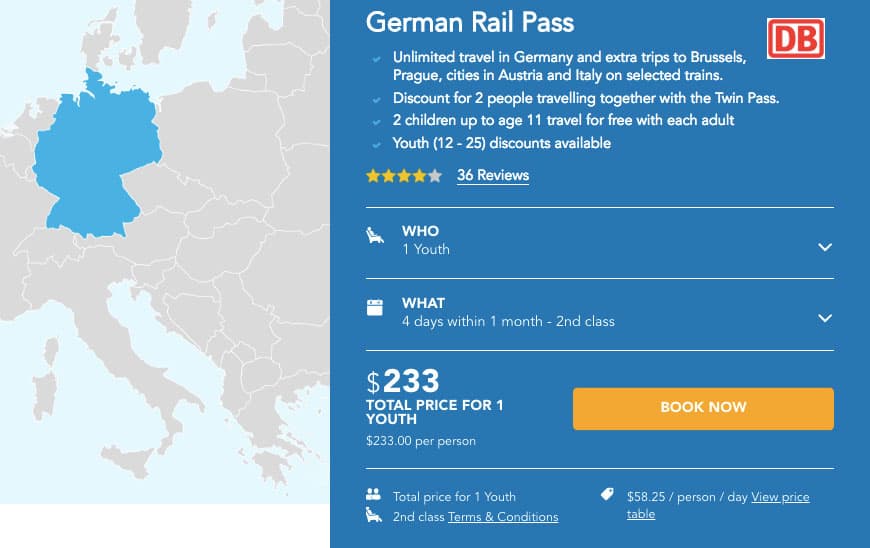
So what’s a better deal—a Eurail pass or single tickets. Well, it depends…
First, you need to look at the per day/per ride cost of the pass — i.e. divide the total cost of the pass by the number of rides it gives you. If you go to Eurail they do a pretty good job of breaking down the per-day price. So, in the image above, a pass that gives four travel days in a month costs $58 (€50) per travel day.
From here you need to estimate how much a single ticket would cost.
The price of a single ticket will vary greatly based on when you buy it and the travel distance. So let’s take a look at a Munich to Berlin ticket.
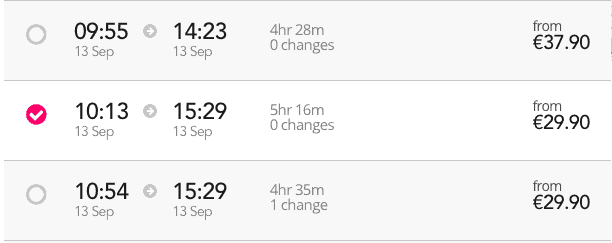
If you buy this ticket four months in advance the price is around €30-€40. So this is quite a bit cheaper than the pass.
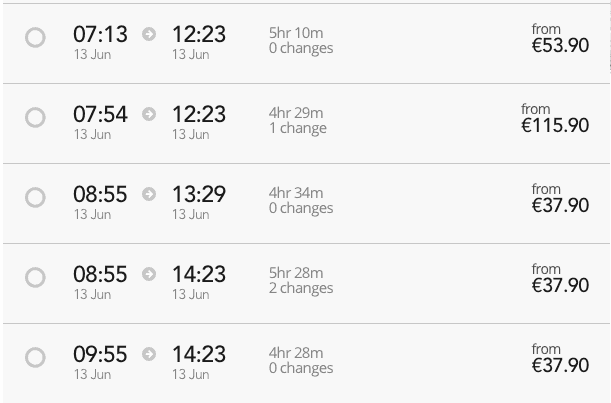
If you buy tickets one month in advance the prices are still fairly affordable at €40-€54. This ends up being a little cheaper or about the same as the pass.
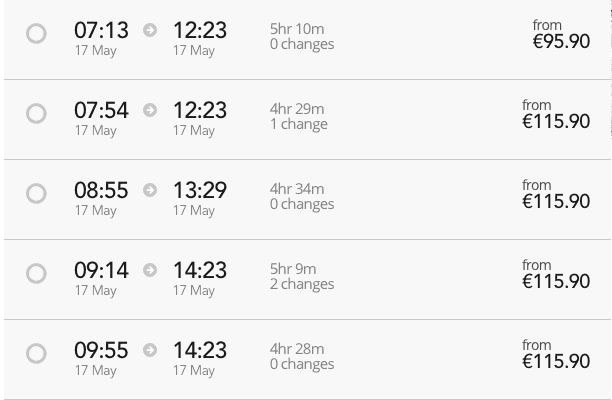
However, when you book less than a week in advance the price skyrockets to well over €50 so a pass is a way better deal.
In conclusion:
Single tickets are almost always cheaper if you buy them a few months in advance but you lose out on flexibility as you have to ride that specific train. Rail passes usually end up being a better deal if your plans aren’t set in stone as you can choose what trains you take on a whim. So we recommend visiting Eurail to see what passes might work for your trip and then do some simple math comparisons.
More Rail Pass Considerations
- 28 & Older: If you’re 28 and over then you’re required to buy a first-class rail pass. This does jack the price up a good amount so it’s less of a deal when compared to 2nd-class single tickets.
- German Rail Twin Pass: When two people travel together they get a 50% discount on the second pass (this is good for both 1st and 2nd class passes). You’ll have to travel on the same train because you’re only given one pass with both your names on it.
More Tips For Riding Trains in Germany
- The Departures Board: You’ll find your train platform via the departure board at the train station. Don’t worry if you don’t see your train because they often only display trains departing within the next 10-20 minutes.
- Self-Service Machines Are In English: Don’t worry if you don’t speak German because the ticket machines (and train station signs) are all in English.
- DB Navigator App: Download Deutsche Bahn’s official app to book tickets, check timetables, and do other helpful stuff.
- Download The Rail Planner App: There are a number of rail apps but we like the Eurail App — it essentially has the timetables/info for every train in Europe and it doesn’t require an internet connection.
- Cheap Tickets Are Non-Refundable: One downside to cheap tickets is that they’re non-refundable and there is a fee to change (but you can’t do it on the day of travel).
- Pack A Picnic: You’re allowed to bring your own food and alcohol on trains. It’s great for those long train rides.
- Luggage: There aren’t any weight limits on luggage and you can bring as much as you want (well, as much as you can carry). Simply bring it on and store it above your head, behind your seat, or in the luggage racks in each car.
- Making Connections: Your trip might require you to change trains along the journey. Don’t worry if there isn’t much time between trains as switching trains are usually fairly quick and easy (it’s not like flying).
- Get To The Train Station Early: Train stations are usually fairly easy to navigate but they can be a little confusing.
- Know Train Station Names: Most large cities have multiple train stations so this often creates confusion. Double-check to make sure you have the right station — especially when booking your ticket. Also, it’s common for there to be stops in the suburbs outside big cities but you won’t want to get off there (just watch what most of the train is doing).
- Changing Stations: Some routes might have you switch train stations in a city to make the journey — pay attention to this because stations are usually far apart.
More Articles About Traveling In Germany

- Berlin City Guide: What to do, see, and eat in Berlin.
- Best Hostels in Berlin: The best cheap places to stay in Berlin.
- How To Choose The Best Travel Insurance: Travel insurance will help cover those non-refundable train tickets if something goes wrong during your trip.
- Packing List For Europe Travel: Tips on packing light — which makes train travel much easier.
- How To Buy Train Tickets In Germany: In-depth guide to buying Germany train tickets.
- Guide To Using Smartphones, SIM Cards, and Data Plans In Europe - August 2, 2025
- Backpacking Europe Packing List — My Europe Travel Packing Guide - July 26, 2025
- The Best Travel Backpacks | In-Depth Buyer’s Guide & Backpack Reviews - July 5, 2025

No Funny Business
The Savvy Backpacker is reader-supported. That means when you buy products/services through links on the site, I may earn an affiliate commission—it doesn’t cost you anything extra and it helps support the site.
Thanks For Reading! — James
Questions? Learn more about our Strict Advertising Policy and How To Support Us.




